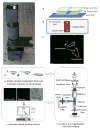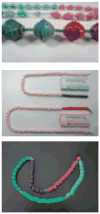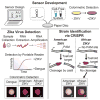Point-of-care diagnostics to improve maternal and neonatal health in low-resource settings
- PMID: 28832061
- PMCID: PMC5636680
- DOI: 10.1039/c7lc00374a
Point-of-care diagnostics to improve maternal and neonatal health in low-resource settings
Abstract
Each day, approximately 830 women and 7400 newborns die from complications during pregnancy and childbirth. Improving maternal and neonatal health will require bringing rapid diagnosis and treatment to the point of care in low-resource settings. However, to date there are few diagnostic tools available that can be used at the point of care to detect the leading causes of maternal and neonatal mortality in low-resource settings. Here we review both commercially available diagnostics and technologies that are currently in development to detect the leading causes of maternal and neonatal mortality, highlighting key gaps in development where innovative design could increase access to technology and enable rapid diagnosis at the bedside.
Figures








Similar articles
-
Unlocking community capabilities for improving maternal and newborn health: participatory action research to improve birth preparedness, health facility access, and newborn care in rural Uganda.BMC Health Serv Res. 2016 Nov 15;16(Suppl 7):638. doi: 10.1186/s12913-016-1864-x. BMC Health Serv Res. 2016. PMID: 28185592 Free PMC article.
-
Maternal and newborn health indicators in Papua New Guinea - 2008-2018.Sex Reprod Health Matters. 2019 Dec;27(1):1686199. doi: 10.1080/26410397.2019.1686199. Sex Reprod Health Matters. 2019. PMID: 31790637 Free PMC article. Review.
-
Effectiveness of the WHO Safe Childbirth Checklist program in reducing severe maternal, fetal, and newborn harm in Uttar Pradesh, India: study protocol for a matched-pair, cluster-randomized controlled trial.Trials. 2016 Dec 7;17(1):576. doi: 10.1186/s13063-016-1673-x. Trials. 2016. PMID: 27923401 Free PMC article. Clinical Trial.
-
Targeted client communication via mobile devices for improving maternal, neonatal, and child health.Cochrane Database Syst Rev. 2020 Jul 14;8(8):CD013679. doi: 10.1002/14651858.CD013679. Cochrane Database Syst Rev. 2020. PMID: 32813276 Free PMC article.
-
Trends and determinants of newborn mortality in Kyrgyzstan: a Countdown country case study.Lancet Glob Health. 2021 Mar;9(3):e352-e360. doi: 10.1016/S2214-109X(20)30460-5. Epub 2020 Dec 10. Lancet Glob Health. 2021. PMID: 33308422 Free PMC article.
Cited by
-
Neonatal resuscitation monitoring: A low-cost video recording setup for quality improvement in the delivery room at the resuscitation table.Front Pediatr. 2022 Nov 2;10:952489. doi: 10.3389/fped.2022.952489. eCollection 2022. Front Pediatr. 2022. PMID: 36405840 Free PMC article.
-
Capillary Force-Driven Quantitative Plasma Separation Method for Application of Whole Blood Detection Microfluidic Chip.Micromachines (Basel). 2024 May 1;15(5):619. doi: 10.3390/mi15050619. Micromachines (Basel). 2024. PMID: 38793192 Free PMC article.
-
Congo red test for identification of preeclampsia: Results of a prospective diagnostic case-control study in Bangladesh and Mexico.EClinicalMedicine. 2020 Dec 22;31:100678. doi: 10.1016/j.eclinm.2020.100678. eCollection 2021 Jan. EClinicalMedicine. 2020. PMID: 33385127 Free PMC article.
-
Review of Health Economics of Point-of-Care Testing Worldwide and Its Efficacy of Implementation in the Primary Health Care Setting in Remote Australia.Risk Manag Healthc Policy. 2020 May 6;13:379-386. doi: 10.2147/RMHP.S247774. eCollection 2020. Risk Manag Healthc Policy. 2020. PMID: 32440241 Free PMC article. Review.
-
From Lab on a Chip to Point of Care Devices: The Role of Open Source Microcontrollers.Micromachines (Basel). 2018 Aug 14;9(8):403. doi: 10.3390/mi9080403. Micromachines (Basel). 2018. PMID: 30424336 Free PMC article.
References
-
- World Health Organization. Health in 2015: From MDGs to SDGs. 2015
-
- World Health Organization, UNICEF, UNFPA, World Bank Group and UN. Trends in Maternal Mortality: 1990 to 2015. 2015
-
- UNICEF. Levels & Trends in Child Mortality; Report 2015. 2015
-
- De Bernis L, Kinney MV, Stones W, Ten Hoope-Bender P, Vivio D, Leisher SH, Bhutta ZA, Gülmezoglu M, Mathai M, Belizán JM, Franco L, McDougall L, Zeitlin J, Malata A, Dickson KE, Lawn JE. Lancet. 2016;387:703–716. - PubMed
-
- United Nations General Assembly. Transforming our world: the 2030 Agenda for Sustainable Development. 2015
Publication types
MeSH terms
Grants and funding
LinkOut - more resources
Full Text Sources
Other Literature Sources

